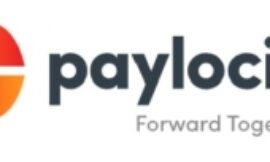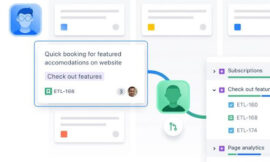Jump to:
Featured partners
LiquidPlanner pricing
LiquidPlanner offers three paid plans (Figure A). The best plan for you depends on your required features. Individuals or those exploring the tool’s capabilities can subscribe to LiquidPlanner’s free plan. It also offers a 14-day free trial, which includes all the capabilities of the Ultimate plan.
Figure A
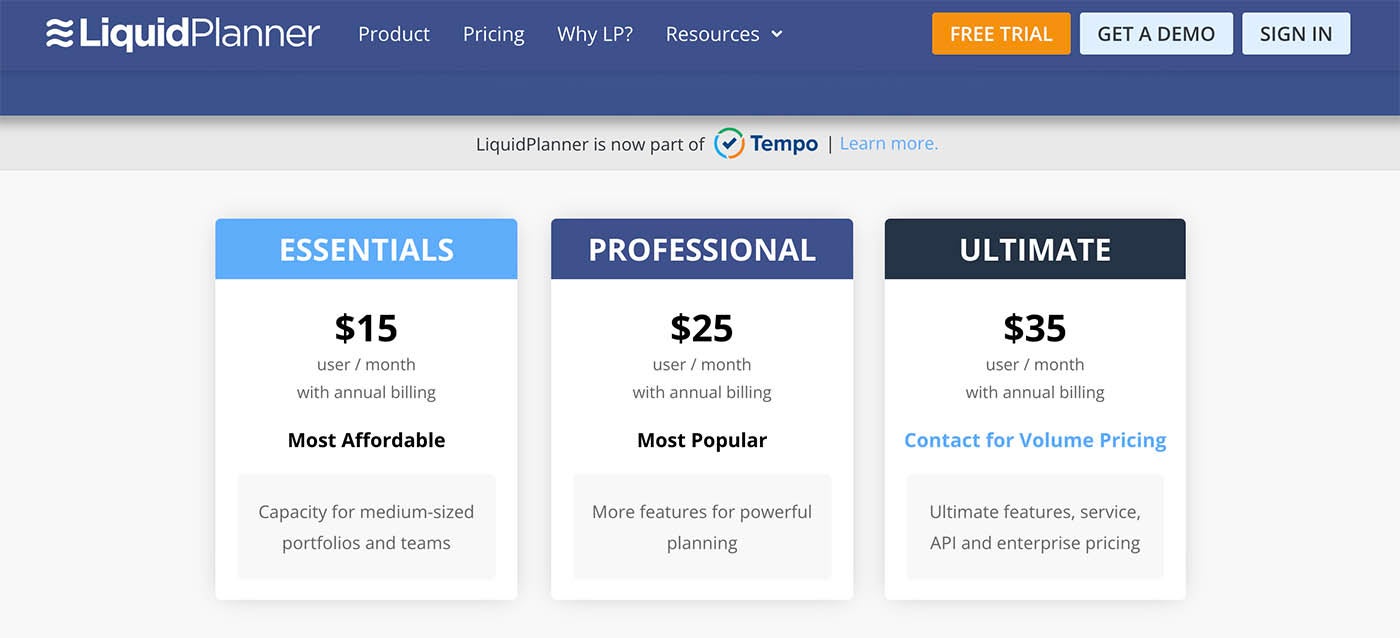
Free plan
LiquidPlanner offers a free plan that allows up to three users, six resources, 10 projects and 300 tasks in one workspace. This plan includes most of the Essentials plan’s features, making it ideal for budget-conscious individuals, freelancers, one-employee businesses and small businesses.
Essentials
LiquidPlanner’s Essentials plan is the cheapest, billed annually at $15 per user per month. This plan is suitable for small and mid-sized teams. The plan includes most of the essential features needed to manage a project, from time tracking to availability management to task and dependency management. The Essentials plan has a maximum task limit of 5,000 and a maximum project limit of 50. Consider the Professional plan if you want to create over 50 projects and 5,000 tasks.
Professional
This plan offers similar capabilities to the Essentials plan. It costs $25 per user per month, billed annually. The following are the features you’ll get with the Professional plan that aren’t available with other lower plans:
- Timesheet review and exports.
- Rate sheets.
- Custom cost codes.
- Custom data fields.
- 50,000 maximum tasks.
- 500 maximum projects.
The Professional plan may benefit you if you require any of the above features.
Ultimate
Large enterprises looking to run unlimited tasks and projects may find LiquidPlanner’s Ultimate plan relevant. It costs $35 per user per month, billed annually. This plan allows you to create unlimited tasks and projects. Its top features include unlimited workspaces, member groups, open API and unlimited workspaces. To determine if the Ultimate plan is best for you, you can sign up for LiquidPlanner’s two-week free trial, which includes all the plan’s features.
Key features of LiquidPlanner
Resource management
With LiquidPlanner resource management capability, you can manage your team’s workloads across projects and dependencies. LiquidPlanner has a resource planning intelligence that aligns people, priorities and projects — it ensures projects are completed on time and within budget.
Figure B
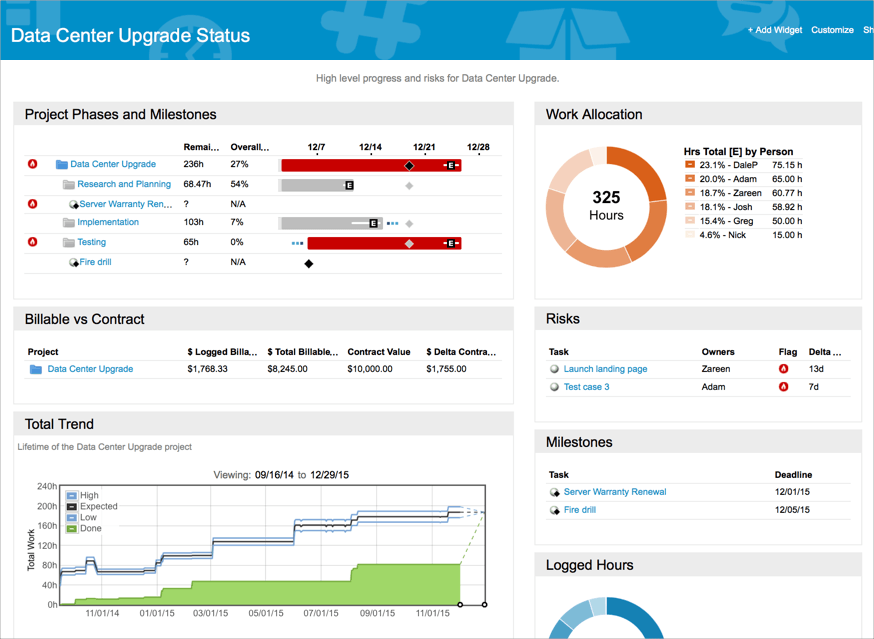
The tool helps you manage resources in five ways:
- It provides key information about each team member in their user profiles.
- It provides resource profiling, which lets you know each team member’s availability for project work.
- LiquidPlanner’s rate sheets allow you to define Pay Rules and Billing Rules to track resource costs and revenue.
- It gives you a bird’s eye view of each team member’s engagements. It tells you what each team member is working on and what resources they are using.
- It provides automatic resource leveling.
LiquidPlanner eliminates overloading with automatic resource management across multiple projects.
Smart schedules
LiquidPlanner’s predictive scheduling and forecasting engine is designed to predict deadlines and automatically adjust schedules based on task changes and project priorities. LiquidPlanner uses Monte Carlo simulations to factor in delays and risks based on priorities, team capacity and ranged estimates when predicting task completion times.
Figure C
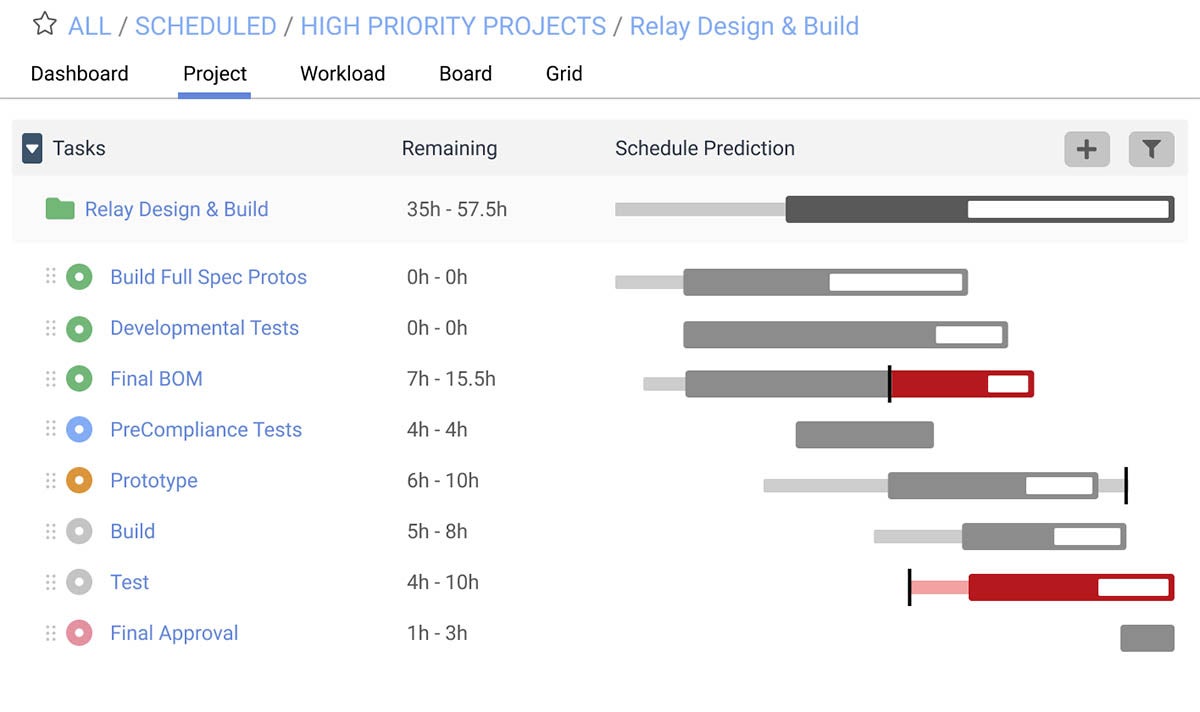
To use the predictive scheduling features, enter your target start and finish dates, assign resources and relative priority and estimate your work. The system will automatically calculate task start and finish dates based on the schedule and resources allocated to determine if you can hit your deadline.
LiquidPlanner also has smart schedule bars automatically created for projects, subfolders, tasks and assignments. These bars identify uncertainty (i.e., lots of white space) and dynamically adapt to change by focusing on tasks that need attention.
Integrated time tracking
Time management is one of LiquidPlanner’s signature features. Tracking time records gives you an understanding of how far you’ve come, clarifies where time was allocated and serves as a blueprint for future tasks. LiquidPlanner’s cost codes enable you to organize and review the work done in the past to aid you in your future planning. Setting up Custom Rate Sheets is also beneficial so billable time can be easily tracked.
Dashboards and views
LiquidPlanner offers three types of dashboards:
- Workspace dashboards: Include data from all projects and packages.
- Package dashboards: Consolidate data across all projects within a package.
- Project dashboards: Capture data from a single project.
LiquidPlanner’s dashboard can be used to visualize progress on projects and tasks within a workspace. The dashboard provides updated information about the current status of individual people, projects and tasks and an overview of the team’s overall progress.
Figure D
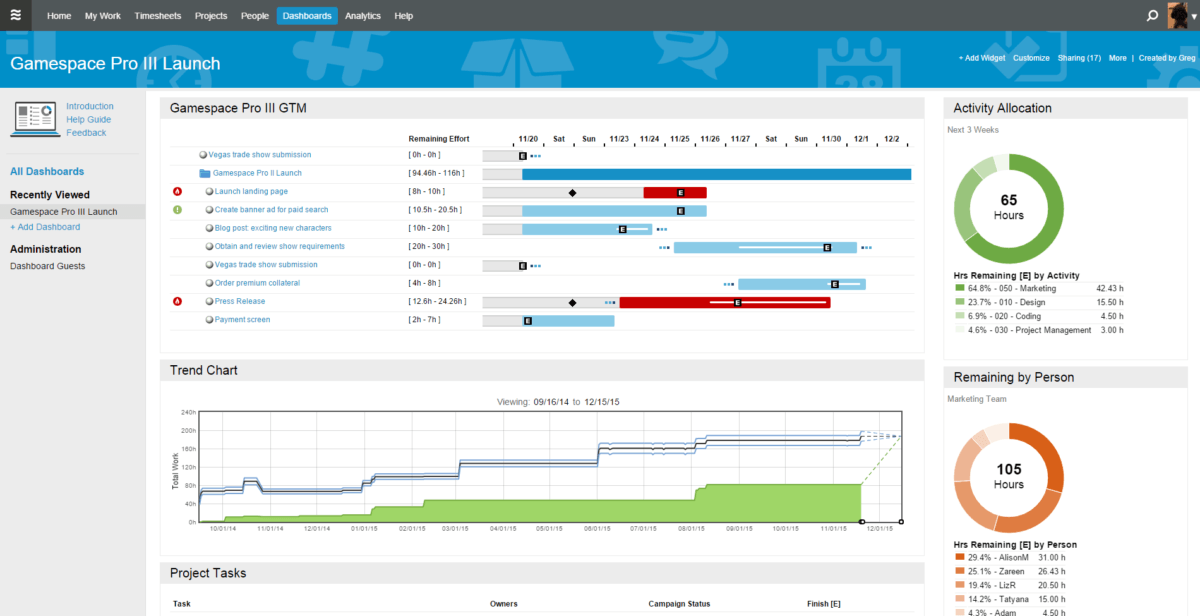
The software has multiple views, including Portfolio, Project, Board and Grid Views. Portfolio views provide an overview of all your projects on LiquidPlanner, allowing you to view current project status, schedule tasks and organize tasks into projects. Project views show individual assignments and tasks organized by team members, visually displaying the effort associated with each task in the workspace. Board views provide a Kanban-style interface to track tasks from creation to completion, and Grid views are available at all levels of the project portfolio.
LiquidPlanner pros
- Free version available.
- Good time tracking capability.
- Its predictive scheduling and forecasting engine makes project planning much simpler and more accurate.
- Priority-based scheduling.
- High level of customization.
- Project access controls enable managers to set location-based access to specific projects.
LiquidPlanner cons
- Too costly for small businesses and startups.
- Complex initial setup and steep learning curve.
- Mobile accessibility is clunky.
- Limited native integrations.
LiquidPlanner Integrations
LiquidPlanner offers document management integrations with Google Drive, Dropbox and Box. It also has native Slack integration. You can also use connectors like Zapier to integrate LiquidPlanner with third-party services, including Salesforce, Jira, Slack, Basecamp, Firebase and more.
Who is LiquidPlanner best for?
LiquidPlanner is best for busy teams that need to stay on top of complex projects and have a lot of different tasks and deadlines to manage. It can be beneficial for teams that need to juggle complex workloads and strict deadlines. Its predictive scheduling and forecasting engine make meeting target finish dates easy.
If LiquidPlanner isn’t ideal for you, check out these alternatives
Although LiquidPlanner is solid project management software, it may not be your best option. Here is how LiquidPlanner stacks up against some of its top competitors.
| Features | LiquidPlanner | ClickUp | Asana | Trello |
|---|---|---|---|---|
| Starting price (billed annually) | $15 per user per month | $5 per user per month | $10.99 per user per month | $5 per user per month |
| Best for | Complex projects | Affordability | Distributed teams | Kanban board |
| Gantt view | Yes | Yes | Yes | No |
| Kanban board view | Yes | Yes | Yes | Yes |
| Task management | Yes | Yes | Yes | Yes |
| Time tracking | Yes | Yes | Yes | Limited |
| Resource management | Yes | Yes | Yes | Yes |
ClickUp: Best for affordability

ClickUp ranks top as one of the best project management software. While LiquidPlanner’s free plan is limited to three people, six resources, 10 projects and 300 tasks, ClickUp offers a more generous free plan. It allows an unlimited number of users and unlimited tasks. They do, however, limit their storage to 100 MB. ClickUp’s paid plans are also less expensive compared to LiquidPlanner’s. It offers over 15 views for projects and tasks, including Gantt Charts, Calendar Views, List Views, Table Views, Mind Maps, Workflows and Doc views.
ClickUp’s key features:
- Real-time chat.
- Kanban boards.
- Sprint management.
- Native time tracking.
- Task management.
For more information on pricing, capabilities, use cases and who it’s best for, read our comprehensive review of ClickUp.
Asana: Best for distributed teams

Asana is one of the best agile project management software. It allows teams to communicate and collaborate on tasks with its wide range of features. Asana is well-suited for teams that need to track progress over multiple projects, especially if those projects involve teams in different locations. It makes it easy for teams to manage tasks and deadlines and share progress updates on one central platform.
Asana’s key features:
- Project and portfolio views.
- Resource management.
- Six views, including lists, boards, calendars, timelines, portfolios and goals.
- Integration with Tableau and Power BI.
- Unlimited storage (100MB per file).
We conducted an in-depth analysis of Asana project management software to help you determine if it’s the best option for you.
Trello: Best for Kanban boards

Best known for its Kanban boards, Trello is also one of small businesses’ best project management software. It is significantly less expensive than LiquidPlanner, and the free version of Trello is enough for most small businesses.
It uses cards to keep track of task details, comments and due dates. Trello boards allow users to invite members, assign tasks, receive reminders and upload attached documents. Trello’s drag-and-drop interface makes it easy to arrange tasks.
Trello’s key features:
- Unlimited boards.
- Advanced checklists.
- Custom fields.
- Unlimited storage.
To determine if Trello is the best project management software for you, read our in-depth analysis of the tool.
Review Methodology
We gathered preliminary information about the product from the vendor’s website, including pricing, features, customer bases and ideal use case. We also reviewed current and past customer feedback on review sites to learn about customer experience and user satisfaction ratings. We then used this data to create a comprehensive and unbiased review of LiquidPlanner project management software.
Source of Article
